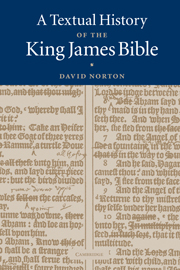Book contents
- Frontmatter
- Contents
- List of illustrations
- Acknowledgements
- List of abbreviations
- PART 1 THE HISTORY
- 1 Making the text
- 2 Pre-1611 evidence for the text
- 3 The first edition
- 4 The King's Printer at work, 1612 to 1617
- 5 Correcting and corrupting the text, 1629 to 1760
- 6 Setting the standard, 1762 and 1769
- 7 The current text
- PART 2 THE NEW CAMBRIDGE PARAGRAPH BIBLE
- PART 3 APPENDICES
- Bibliography
- General index
- Word index
- Index of biblical references
1 - Making the text
from PART 1 - THE HISTORY
- Frontmatter
- Contents
- List of illustrations
- Acknowledgements
- List of abbreviations
- PART 1 THE HISTORY
- 1 Making the text
- 2 Pre-1611 evidence for the text
- 3 The first edition
- 4 The King's Printer at work, 1612 to 1617
- 5 Correcting and corrupting the text, 1629 to 1760
- 6 Setting the standard, 1762 and 1769
- 7 The current text
- PART 2 THE NEW CAMBRIDGE PARAGRAPH BIBLE
- PART 3 APPENDICES
- Bibliography
- General index
- Word index
- Index of biblical references
Summary
Introduction
The text of the KJB is commonly thought to be the fixed and stable work of one collection of translators. This is not the case. First, as the translators recognised, it is a revision of earlier work. In the Preface, they declare:
Truly (good Christian Reader) wee neuer thought from the beginning, that we should neede to make a new Translation, nor yet to make of a bad one a goodone … but to make a good one better, or out of many good ones, one principall good one, not iustly to be excepted against; that hath bene our indeauour, that our marke.
The KJB, first printed in 1611 by the King's Printer Robert Barker, is the culmination of a sequence of work begun by William Tyndale and continued by Miles Coverdale, the Great Bible, the Geneva Bible, the Bishops' Bible and the Rheims New Testament (to name only the chief predecessors). Second, the development of the text did not stop with the publication of the translators' work in 1611. Changes — sometimes deliberate, sometimes accidental, some for the better, some not — were made in subsequent printings by the King's Printer. From 1629 on, editorial work on the text began to be a major factor in creating the texts that we have today: the spelling was modernised, changes were made in the translation, and the punctuation was revised. Most of the changes were made by 1769, but work of this sort has never quite ceased.
- Type
- Chapter
- Information
- A Textual History of the King James Bible , pp. 3 - 28Publisher: Cambridge University PressPrint publication year: 2005



